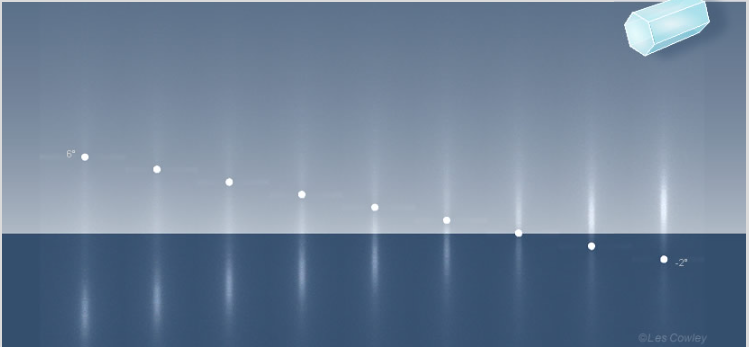Column crystal pillars - Solar altitude
Column Crystal Pillars - Exploring the Relationship with Solar Altitude
When it comes to atmospheric optics, column crystal pillars offer a fascinating spectacle. These pillars can reach impressive heights, even when the sun is several degrees above the horizon. In this article, we will delve deeper into the intricacies of these intriguing phenomena and explore their relationship with solar altitude.
Column crystal pillars are known for their inherent faintness. In comparison to the brighter plate pillars, they require a significantly higher number of rays to generate each pillar. For instance, in a HaloSim simulation, 100 million rays were generated for each column pillar, while only 10 million rays were needed for the plate pillars. This disparity highlights the delicate nature of these ethereal structures.
Interestingly, the appearance and height of column crystal pillars are not strongly influenced by crystal tilts. Even when well-aligned crystals are used, the impact of crystal tilts on column pillars is minimal. This suggests that other factors play a more significant role in determining their characteristics.
To gain a better understanding of column crystal pillars and their relationship with solar altitude, let us explore some key aspects:
1. Solar Altitude and Pillar Height
The height of column crystal pillars is closely linked to the solar altitude. As the sun rises higher in the sky, the pillars tend to become shorter. Conversely, when the sun is lower on the horizon, these pillars can reach impressive heights. This relationship between solar altitude and pillar height adds to the mystique surrounding these optical phenomena.
2. Atmospheric Conditions
The atmospheric conditions also play a crucial role in the formation and visibility of column crystal pillars. The presence of ice crystals in the atmosphere is essential for these pillars to occur. Additionally, factors such as temperature, humidity, and the size and shape of the ice crystals all contribute to the formation and appearance of these ethereal structures.
3. Optical Illusion
Column crystal pillars can create an optical illusion, making them appear taller than they actually are. This illusion is a result of the interaction between the light rays and the ice crystals in the atmosphere. As the light passes through the crystals, it gets refracted and scattered, creating the illusion of an elongated pillar reaching towards the sky.
4. Pillar Colors
The colors observed in column crystal pillars are a result of light scattering and interference phenomena. The pillar colors can vary depending on the size and shape of the ice crystals, as well as the angle at which the light interacts with them. From vibrant hues of red and orange to subtle shades of blue and green, the colors exhibited by these pillars add a captivating element to their visual spectacle.
5. Observing Column Crystal Pillars
To observe column crystal pillars, it is best to find a location with a clear view of the horizon. As the sun approaches sunrise or sunset, the chances of witnessing these phenomena increase. Patience is key, as these pillars may not always be visible, and their appearance is highly dependent on atmospheric conditions. However, when they do appear, they offer a mesmerizing display that is well worth the wait.
6. Photography Tips
Capturing the beauty of column crystal pillars through photography can be a rewarding experience. To enhance your chances of capturing stunning images, consider the following tips:
- Use a tripod to ensure stability and minimize camera shake.
- Experiment with different exposure settings to capture the delicate details of the pillars.
- Pay attention to composition and framing to create visually appealing photographs.
- Take advantage of the pillar colors by adjusting white balance settings or using filters.
In conclusion, column crystal pillars are a captivating phenomenon within atmospheric optics. Their height, appearance, and relationship with solar altitude make them an intriguing subject of study. By understanding the factors that contribute to their formation and visibility, we can appreciate the awe-inspiring beauty they bring to our skies. So, keep an eye out for these ethereal structures during the right atmospheric conditions and prepare to be mesmerized by their enchanting presence.

Upper column pillars can be comparatively tall even when the sun is several degrees above the horizon.
They are intrinsically faint. In this HaloSim simulation 100 million rays generated each pillar compared with the 10 million rays for the brighter plate pillars. Well aligned crystals were used but column pillar appearance and height are not strongly influenced by crystal tilts.
Note: this article has been automatically converted from the old site and may not appear as intended. You can find the original article here.
Reference Atmospheric Optics
If you use any of the definitions, information, or data presented on Atmospheric Optics, please copy the link or reference below to properly credit us as the reference source. Thank you!
-
<a href="https://atoptics.co.uk/blog/column-crystal-pillars-solar-altitude/">Column crystal pillars - Solar altitude</a>
-
"Column crystal pillars - Solar altitude". Atmospheric Optics. Accessed on April 20, 2024. https://atoptics.co.uk/blog/column-crystal-pillars-solar-altitude/.
-
"Column crystal pillars - Solar altitude". Atmospheric Optics, https://atoptics.co.uk/blog/column-crystal-pillars-solar-altitude/. Accessed 20 April, 2024
-
Column crystal pillars - Solar altitude. Atmospheric Optics. Retrieved from https://atoptics.co.uk/blog/column-crystal-pillars-solar-altitude/.